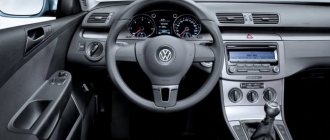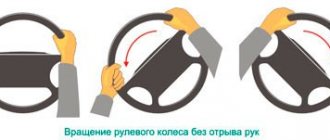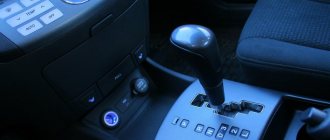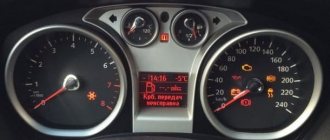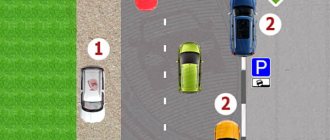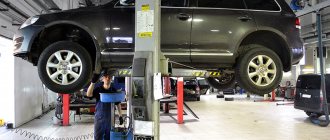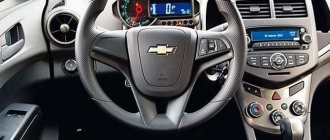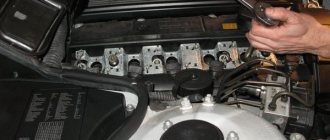For novice drivers, the greatest difficulties are caused by the technique of overtaking and parking. Also of particular importance is the question of how to turn correctly when cornering. In this article we will look at techniques for turning a car .
Moving a car involves performing various driving techniques and maneuvers, which include the so-called turn. To learn how to turn correctly when turning, you need to master the turning technique.
The correct turn is characterized by accuracy, speed, safety, which is accompanied by an appropriate response from the driver in certain driving conditions and is performed in accordance with established traffic rules.
Technique for turning a car
Mastering the turning technique involves learning four basic techniques:
- Driving along a straight road - that is, approaching a turn;
- Directly entering a turn , which is accompanied by turning the steering wheel;
- Car movement in a turn;
- Exiting a turn is accompanied by the driver returning the steering wheel to its original position.
The correct turn of the car is influenced not only by the speed and trajectory of the car during the turn, but also by the operating mode of the engine.
How to drive an automatic transmission correctly - tips for driving a car with automatic transmission
Currently, more and more cars are coming off the assembly line equipped with an automatic transmission. The thing is that in city mode with traffic jams and constant stops at traffic lights, an automatic transmission is very convenient, saving a lot of nerves and time for the driver.
In this article, we will analyze in detail all the intricacies of operating a car with an automatic transmission: how to start the vehicle, how to get started correctly, and what you should never do.
Vehicle speed when turning
Before entering a turn, you must reduce the vehicle speed. It should be remembered that while the car is passing through an arc, it is necessary to maintain a constant speed.
The safety of turning depends on the vehicle turning correctly. To make a safe turn, you should begin to reduce speed on a straight section of the road well before the turn, which eliminates the effect of wheel slipping and the possibility of the car skidding when turning.
We briefly looked at what you need to consider when approaching a turn - speed and trajectory. And now in more detail about the driver’s actions when entering a turn, driving in a turn and exiting a turn.
Trajectory
If the goal is to achieve the best lap time, you need to make the most of the road width. To go through a turn as quickly as possible, you need to move along the smallest radius from the entry point to the exit point. In other words, at the entry point you begin to turn towards the apex, after passing the apex you need to begin straightening, which ends at the point of exit to the straight line. This is the description of the ideal trajectory when driving on a race track. But there are extreme situations in which the trajectory of movement undergoes changes to obtain benefits:
- late entry. In this case, the apex moves towards the outer edge of the turn, and therefore, when moving towards the apex, the trajectory is more straightforward. A late apex allows you to begin straightening earlier, and, consequently, acceleration. This gives a significant advantage if there is a long straight section around the bend;
- early entry. Cutting the entry arc is used when overtaking an opponent on the track. The driver starts braking later, heading towards the apex at a greater angle, therefore covering less distance. This allows you to block the opponent's ideal trajectory and forces him to move to the outer edge of the turn.
If the road bend has a complex shape, there may be several apexes in the arc.
Correct entry of the car into a turn
So, correct entry into a turn implies an early reduction in speed before the turn, which will ensure that the turn is passed at a reduced speed. The vehicle speed before turning should be selected depending on the turning conditions and the condition of the road section. In unfavorable road conditions, in the presence of possible additional obstacles, the speed when turning should be significantly reduced.
Before the car enters a turn, you should pay attention to the point of fixation of attention and the position of your hands on the steering wheel.
When turning, the driver's attention should be directed to the exit point of the turn (that is, the driver must imagine the final picture of the turn, its result).
If the driver is unable to view and visualize the result of the turn, or visibility is obstructed, measures should be taken to reduce the vehicle speed as much as possible before the turn.
What not to do with automatic transmission
Despite the fact that an automatic transmission seems easy to operate and is designed to make driving easier, there are still restrictions and prohibitions, adhering to which, the automatic transmission will last a long time and without complaints.
Restrictions and prohibitions when driving with an automatic transmission:
Manufacturers have provided a long service life for automatic transmissions, but subject to certain rules.
If you do not adhere to them, then the time to repair the automatic transmission will get closer with each incorrect action. Repairing an automatic transmission is an expensive pleasure.
Source
Diagram of the correct turn of the car
- Before turning, the driver smoothly depresses the brake pedal to reduce speed (if necessary, a lower gear can be used).
- Determining the vehicle's trajectory. The steering wheel is turned with both hands, according to the grip pattern.
- The driver's gaze is fixed on the point where the car exits the turn. When the car passes through a turning arc, a constant speed is maintained.
- Exiting a turn is accompanied by the steering wheel returning to its original position and a smooth increase in vehicle speed.
A novice driver must practice the technique of making turns Over time, drivers become overconfident when making various difficult turns, which can affect driving safety. Don’t take risks, control yourself, follow the technique of making turns. Bring the correct technique for performing a turn to automaticity. Have a safe ride.
What is an automatic transmission
An automatic transmission is one of the types of transmission in which the required gear ratio is automatically selected without driver intervention, taking into account the nature of the movement, speed and other parameters.
In a car with an automatic transmission, there is no clutch pedal due to the fact that the clutch is replaced by a torque converter, which transmits torque to the wheels.
Starting a car with automatic transmission
To ensure the safety of the automatic transmission, several types of protection are provided in the car.
Hand position on the steering wheel
To explain the layout of the hands, let’s imagine that the steering wheel is divided into separate sections and represents a dial. The first value is the area where the right hand is located, the second value is the location of the left hand. Thus, the number 4 is the right hand, and the number 12 is the left hand.
It is important to remember that your palms must always be kept on the steering wheel; to change the position of the hand (or grip), the tactic of sliding along the steering wheel is used.
Basic Requirement
The topic of using the steering wheel and pedaling during casual maneuvers was covered in the description of the friction diagram: the driver needs to use the grip on the track most effectively at the moment of braking, turning the steering wheel and accelerating. The key to successful completion is to smoothly complete all three stages in one movement.
Cornering is divided into three stages: braking, turning and accelerating.
200g › Blog › Managing with confidence! part 2
Turning, especially on difficult surfaces, especially with minimal losses in speed, is not the easiest task even for professional racers.
We must remember
that front-wheel drive and all-wheel drive cars become very “vulnerable” in high-speed turns on soft ground or uneven surfaces. At large wheel angles and maximum traction, the front wheel drives (especially the “thrust” drive, the outer drive relative to the turn) experience extreme loads. Professional racers know that the tighter the wheels are turned, the less traction should be. Non-professionals, pressing the gas pedal to the floor when turning, are often left without a drive. In these situations, machines with a "rowing tail" are more reliable, since the problem of "twisted" drives does not apply to them. In addition, on rough roads, many athletes starting on all-wheel drive SUVs often damage their transfer cases. This occurs with repeated alternation of sharp acceleration and emergency braking. So some people simply disable the front axle (on those models where this is possible). Losing in dynamics when using only rear-wheel drive, they maintain a margin of safety by connecting all-wheel drive only in those situations where it provides an undeniable advantage.
In fact, the control technique, as well as the behavior of cars with different drives when cornering, are practically the same if the speed is low and the road grip is good. The difference in drives is most noticeable when cornering at high speeds or when tires have poor grip on the road.
Take, for example, entering a turn at high speed with a simple “roll-in”
, eliminating lateral wheel slip. In case of control errors (excessive traction), a rear-wheel drive vehicle is susceptible to skidding of the rear axle, a front-wheel drive vehicle is susceptible to the front wheels drifting, and a full-wheel drive vehicle is susceptible to longitudinal sliding. In case of errors of the opposite nature (the gas pedal is completely released on the turning arc), the rear- and all-wheel drive car drifts out, and the front-wheel drive one slips into a skid with its rear wheels. Many people believe that front-wheel drive cars have an advantage on winding roads. And they are somewhat right. There are many precedents when a front-wheel drive car, having less engine power, wins mountain races even against all-wheel drive cars, not to mention rear-wheel drive ones.
If we consider the features of driving cars with different drives in turns, then it is best to be transported to the world of high-speed rally sections with slippery gravel or snow surfaces.
For rear wheel drive
The technique of “controlled skidding”
is extremely relevant . Where “rolling in” motion becomes dangerous due to possible drift of the front wheels, racers artificially adjust the skidding angle by slipping the rear wheels and use part of the engine power to counteract the lateral forces of inertia. Keeping a car in a continuous sideways slide requires great skill. On average, a rider performs up to four movements with his arms and legs per second with an amplitude depending on the level of training. Experienced athletes react faster to car deviations, and their actions are more laconic than those of inexperienced athletes who are constantly late and are forced to constantly “catch” the car in the stable sliding phase. Although drifting (moving in a controlled skid) looks very impressive, in fact such a maneuver significantly reduces speed. Ring racers who don’t use skidding technology always chuckle when they watch rally drivers try to sideways around a corner on the asphalt. Although, on gravel or ice, their ridicule will often be “irrelevant”, because there is no other way to protect themselves from a dangerous situation.
For front-wheel drive models
there is a wider choice of techniques for extreme driving conditions.
Track racing drivers use "ballistic" propulsion.
. By turning the wheels to a “medium” angle, they apply measured traction, eliminating powerful slipping. The peculiarity of front-wheel drive is that it reacts to a decrease in traction by deflecting into the turn, and to excess traction by sliding to the outer edge of the circle. And another feature is the dependence of the amount of traction on the angle of rotation of the wheels. The steeper the wheels are turned, the less traction there should be, otherwise the front axle will start to drift. The response of the front-wheel drive to the level of traction allows you to “steer with the gas” rather than with the front wheels.
Another technology that rally drivers have invented for front wheel drive is propulsion
not along a classic arc with a constant radius, but
along a polyhedron
. In another way, this technology can be called “tack movement”. This term comes from sailing. The essence of the technology is that a front-wheel drive car can be turned with its rear wheels using three techniques to choose from.
— Firstly, this is a “gas brake”
. By braking on an arc with your left foot without releasing the gas pedal, you can easily turn the car at an angle from 5 to 180 degrees by locking the rear wheels.
- Secondly, this is turning the car by locking the wheels with the parking brake
. This technique is used in very sharp and reverse turns, as well as in cases where an erroneous turn of the steering wheel to the “all the way” position led to an uncontrolled sliding of the car.
- Thirdly, this is also a turn of the car using a skid of the rear wheels, which occurs as a result of the gas pedal being released.
.
This technique was invented by circuit racers to enter a turn at extreme speeds. But, I note, this technique is both very good and very dangerous.
On the one hand, this is a vivid example of high-speed cornering with a guarantee of safety for the front wheels, which can slip off the trajectory. To prevent this from happening, racers make an interesting exchange: due to a partial loss of stability (controlled skidding), they increase the car's controllability, reducing its turning angle. The other side of the coin is a mistake that leads the automobile amateur to an emergency situation (critical skidding, rotation). When the driver enters a turn and is frightened by high speed, he reflexively releases the gas pedal, not realizing that this “turns on” the “skid” program. And the more passive the driver, the more serious the skid. In such situations, professionals recommend: “ If your front-wheel drive car loses control, point the wheels where you want to go and press the accelerator, forget about the rear wheels altogether and think only about the front wheels .” In most cases, the situation can be corrected.
Source

